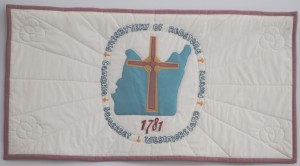The Presbytery of Redstone was organized on Sept. 19, 1781 by the Synod of New York and Philadelphia. While the current territory of the presbytery consists of four counties in the southwestern corner of Pennsylvania, the original landscape stretched from the Allegheny Mountains to the east, as far north as Lake Erie, to the south to Virginia and “on the west by the setting sun.”
 There were no geographical limits and no churches named when the presbytery was set up except for one in Laurel Hill and four ministers west of the Allegheny Mountains. The presbytery got its name “Redstone” from the rocks in the banks of Redstone Creek one mile below Brownsville. A vein of coal was set on fire one day either by Indians or the friction from a landslide, and when the fire died out it left behind a bank of “red stones.”
There were no geographical limits and no churches named when the presbytery was set up except for one in Laurel Hill and four ministers west of the Allegheny Mountains. The presbytery got its name “Redstone” from the rocks in the banks of Redstone Creek one mile below Brownsville. A vein of coal was set on fire one day either by Indians or the friction from a landslide, and when the fire died out it left behind a bank of “red stones.”
The Rev. Chas Beatty is said to have preached the first Protestant sermon in these parts on Thanksgiving Day of 1758 at Fort Duquesne. Beatty had been sent by the Synod of Philadelphia to explore the country and check out what could be done in terms of missionary work. In the 1770s, the Rev. James Finley traveled here several times and helped establish the Rehoboth and Round Hill churches in 1778. The Rev. James Power was the first minister to remain in the Redstone area and in 1774 started Dunlap’s Creek Presbyterian Church, which was “the oldest organization west of the mountains.”
The first meeting of the presbytery on Sept. 19, 1781 was held at Pigeon Creek Church instead of Laurel Hill as originally planned “because the incursions of the savages into Washington county rendered it very undesirable for the ministers to leave their homes.” In 1788, the first General Assembly was formed and the Synod of New York and Philadelphia was divided into four synods (Philadelphia, New York and New Jersey, Virginia and the Carolinas). Redstone took its place in the Synod of Virginia, but its vast boundaries went unchanged. The creation of the Presbytery of Ohio in 1793 gave some of Redstone’s territory to that region, decreasing its size and making its western boundary now the Monongahela River.
The Presbytery of Erie was created in 1801 with more land taken away from Redstone, and a year later Redstone was moved into the new Synod of Pittsburgh. This means that the Presbytery of Redstone was part of the first three synods in the United States and the first General Assembly.
Education has played an important role in the life of the presbytery. Early pastors saw the need to educate its young men so that they could continue to preach the Gospel. In 1791, the presbytery asked the Synod of Virginia to create an avenue for “education of pious young men for the ministry.” The Synod recommended establishing two schools, which eventually became Washington College and Jefferson College and later combined into Washington & Jefferson Academy.
Mission work is another staple of the Presbytery of Redstone. The early members not only ministered to their own people, but they also traveled to “waste places, sought out destitute ones and organized them into churches and watched over them till pastors could be obtained.” Because of transportation difficulties at that time, it is written that preachers would swim across a creek or river on Sunday morning and preach in wet clothes before moving on. Had hard rain swelled the river, it was common for a pastor to have to retreat following the two-day ride it took them just to get to that point.
Today, there are 70 congregations from the counties of Westmoreland, Fayette, Somerset and Cambria that reside in the Presbytery of Redstone. The presbytery continues to have a partnership with the Presbyterian Church in Sudan and South Sudan.
As a result of an initial gift, First Presbyterian, Johnstown and subsequently the Presbytery of Redstone initiated the Pine Springs Camp (in Redstone territory—Jennerstown). Since 1981, Redstone has shared the oversight and administration of this ministry with Washington Presbytery.
